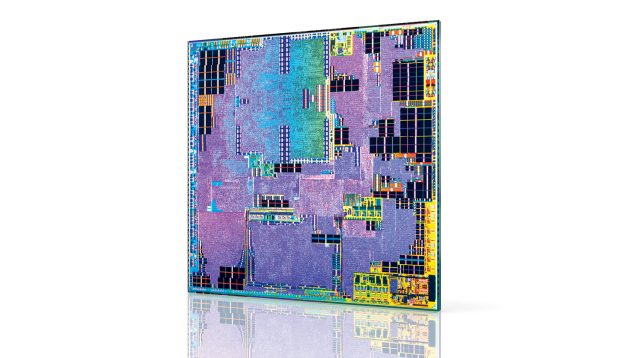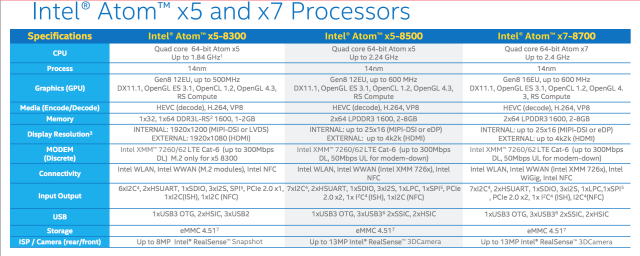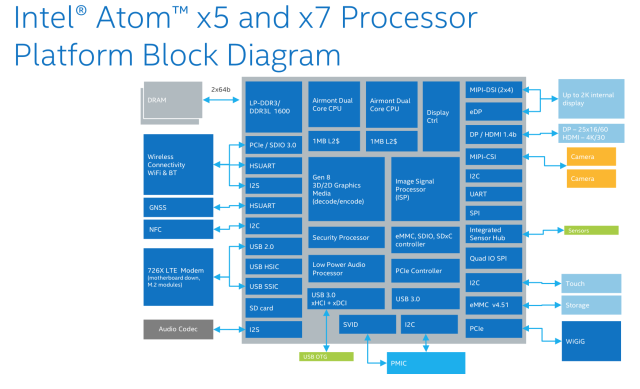
BARCELONA, Spain—At Mobile World Congress 2015, Intel has unveiled its latest in a very long line of attempts at securing a beachhead in the mobile market: the Atom x3, Atom x5, and Atom x7 SoCs.
As the naming implies, the Atom x3 is a low-end part that is probably destined for developing markets in countries such as India and China. The Atom x5 and x7, however, are quad-core 14nm Cherry Trail chips with Broadwell-class Intel HD graphics. Performance-wise, the x5 and x7 chips should be pretty good—but right now we only have Intel's own benchmarks to go on. There's also no word from Intel on the power consumption of the new chips, which is rarely a good sign when you're trying to break into a highly competitive, entrenched market.
Let's start at the bottom. Atom x3 is essentially rebranded SoFIA, but now along with a 3G version there is a new chip (the x3-C3440) with an integrated LTE modem. Rather unusual despite its use of the Atom brand name, the x3 is a 28nm chip that isn't being built at Intel's own fabs. Instead, Intel is using TSMC as a foundry, primarily because it isn't cost effective for Intel to build chips with integrated modems on its own bleeding-edge 14nm node. The top-end Atom x3, the x3-C3440, has a quad-core CPU and Mali 720 MP2 GPU (yes, that's a GPU designed by ARM Holdings). We probably won't see the Atom x3 in Western markets; it will be cheaply fabricated in Asia, and it will be used in very cheap phones and tablets. We have asked Intel what CPU core is being used by Atom x3, but the company hasn't yet responded.
Updated: Intel has confirmed that the Atom x3 is being manufactured on TSMC's 28nm process. The post has been updated.

The Atom x5-8300, Atom x5-8500, and Atom x7-8700 are Intel's first mobile chips based on the Cherry Trail platform—the 14nm version of Bay Trail. On the CPU side of things (they're all quad-core Airmont parts, incidentally), the die shrink doesn't move the bar very far. I'm sure Intel made a few tweaks under the hood, but we're only talking a few percentage points of improvement in real-world use. The jump from Gen 7 to Gen 8 Intel HD graphics, however, is significant. Rather than Bay Trail's rather weak Ivy Bridge-class GPU, the new Atom x5 and x7 chips will use a pared-down Broadwell-class GPU. We are loathe to provide any numbers without actually benchmarking an Atom x5 or x7 device, but in the case of the x7-8700, which has 16 execution units, we could be looking at a very sizable bump in graphics performance (upwards of 50 percent).

When it comes down to it, though, the mobile war isn't waged on GPU performance. Yes, absolute CPU and GPU performance are nice to have, but they are unanimously trumped by price and power consumption. The Intel slide deck mentions in passing that the Atom x3 is "low power," but the power consumption of Cherry Trail isn't mentioned at all. Suffice it to say, we look forward to doing some actual power consumption benchmarking when we get our hands on some shipping hardware. We can't imagine that Intel is very excited about Samsung mass producing its own 14nm chips, either—usually the company could lean on its manufacturing lead to make up for any other shortcomings, but Samsung has hit 14nm a lot faster than anyone expected.
reader comments
61